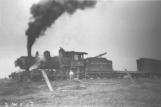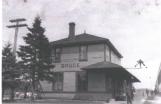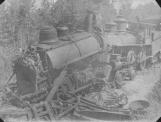2
After the Bruce Mines were closed in 1876, the miners left to find employment elsewhere. This would change the development and growth of the area; from a thriving mining town to a village center supported by a sparsely populated farming community and the lumbering companies operating in the area.Prosperity of a short duration hit Bruce Mines when the Canadian Pacific Railway was built late in 1886 and into 1887. The company used the tailings, waste rock, from the Bruce and Wellington mine operations to ballast the track of the CPR.
The original Bruce station was built in 1906, and replaced with a "new" building in 1926.
Photo courtesy of the Canadian Pacific Railway, CPR Archives. Reproduced with permission.
3
In 1899 the Bruce Mines and Algoma Railway Company was chartered to build a line north to Rock Lake from a junction at Bruce Station on the CPR Sault Branch. Construction started in 1900 from the CPR's Bruce Station. Progress was slow but the line was completed in the autumn of 1901. Residents in the area rejected the railway's official name and even seldom used its initials, the B. M. and A. Instead, they settled on the euphemism "The Nip and Tuck", indicating their reservations as to the success of the operation and the financial stability of the enterprise.In 1903 the Rock Lake mine closed, depriving the railway of its primary customer. In 1904 in an effort to generate business, the B. M. and A. extended its track through Bruce Mines and over to Jack's Island on a long trestle. A 400-foot, three-track coal dock was constructed and coal was transported to the CPR line at Bruce Station and then on to different mill towns, such as Massey and Blind River.
5
On July 14, 1905, the Bruce Mines and Algoma Railway's two engines were involved in a head-on collision halfway between Bruce Station and Bruce Mines. One of the engineers, James F. Duncan, died in the crash.Photo courtesy of Chris Moes.
6
The small engine was reported scrapped, and the large one sold to timber operators on St. Joseph Island. Operating statistics were not submitted to the Federal government in 1905 and the following year the railway was listed as inactive.7
Sam West in Bryans' field with the Bruce Mines and Algoma Railway engine.1915
Plummer Township, Ontario, Canada

8
In 1913 the B. M, and A. (the Nip and Tuck) was reorganized and renamed the Lake Huron and Northern Ontario Railway Company. The railway's finances were still such that even major repairs were put on hold. One story has it that the engineer and fireman had a system when crossing the aging trestles (bridges). The train would stop when approaching a questionable trestle crossing the Thessalon River; the engineer would disembark and walk across. The fireman would tie open the throttle slightly, and then he too would disembark. The train would proceed slowly across the unsteady trestle, unmanned. Once it was safely across, the engineer would jump back on, stop the train, and wait for the fireman to walk across the trestle. They would then continue on their scheduled route.When finding references to the railway, even as late as 1915, the area residents still called it the Nip and Tuck.
Photo courtesy of Ian West.

